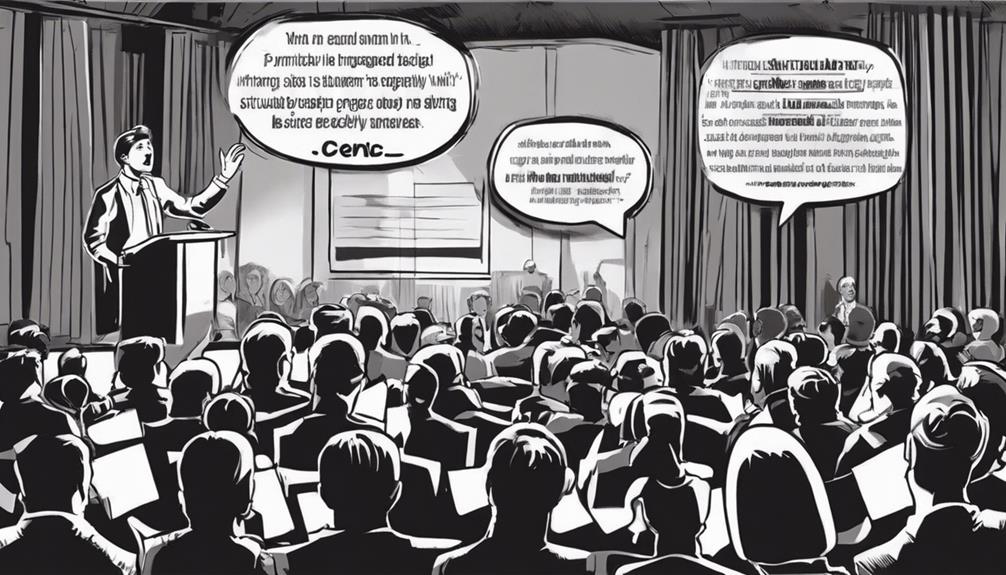Parenting Tips
Seeing the World Through Your Child's Eyes
Navigate the unique perspective of your child to foster deeper connections and better understand their world—discover how empathy can transform your parenting journey.

Seeing the world through your child’s eyes lets you understand their experiences, emotions, and challenges more deeply. They see adults as powerful giants, fostering dependence and trust. Show empathy by actively listening and validating their feelings, creating a safe space for honest talk. Notice their struggles in reading, math, and writing, and offer help to boost their confidence. If your child has trouble with attention or organization, break tasks into small steps and use visual aids. **Encourage a growth mindset** and praise efforts to transform their self-image. These insights can deepen your bond more than you think.
Key Takeaways
- Observe your child's expressions and body language to gain insights into their perspective and feelings.
- Listen actively and validate their emotions to foster trust and understanding.
- Create a safe space for open communication, allowing them to express their thoughts freely.
- Engage in activities together, seeing things from their level and experiencing their world.
- Encourage storytelling and imaginative play to understand their view of the world and boost creativity.
Understanding Their Perspective
Understanding your child's perspective begins with recognizing that they see adults as powerful giants, which fosters a sense of dependence and trust. This dynamic plays a significant role in family life, shaping how children interact with you and the world around them.
As a parent, you're in a unique position to connect with your family by genuinely seeing the world through your child's eyes. Children rely on you to meet their needs and help them navigate their environment. By understanding their viewpoint, you can foster better communication and stronger relationships.
Maria Montessori's concept of 'following the child' emphasizes the importance of tuning into your child's feelings, reactions, and unique perspectives. Observing how your child expresses themselves, whether through crying, words, or non-verbal cues, can provide valuable insights into their needs and desires.
As your child grows, their methods of communication and expressions of independence evolve. By remaining attentive and empathetic, you'll not only support their development but also create a nurturing and understanding family environment. This deep connection will help you see the world from your child's perspective, enriching your family life and strengthening your bonds.
Empathizing With Emotions

Empathizing with your child's emotions involves actively listening and validating their feelings, which helps them feel truly heard and understood.
When you acknowledge their emotions without judgment, you create a safe space for open communication, fostering trust and connection.
Validating Their Feelings
Recognizing your child's emotions and validating their feelings is essential for building a strong, trusting relationship. When you take the time to see the world through their eyes, appreciating the simple things that bring them joy or sadness, you help them feel truly understood. By acknowledging their feelings, whether they're happy, sad, or frustrated, you communicate that their emotions matter and are valid.
When you empathize with your child's emotions, you foster a deep parent-child bond. This connection is important because it encourages them to open up and share their inner world with you. As they learn that their feelings are important and respected, they develop emotional intelligence, which is invaluable for their personal growth and future relationships.
Validating their feelings also promotes open communication and trust. When your child feels heard and accepted, they're more likely to come to you with their concerns, fears, and joys. This sense of safety and support is essential for their mental and emotional well-being.
Active Listening Techniques
Active listening means you fully focus on what your child is saying, showing empathy and understanding through your responses and body language. When you practice active listening, you're not just hearing words; you're diving into the world through your child's eyes. This means acknowledging and validating their emotions, whether they're happy, sad, or frustrated.
To truly listen, make eye contact, nod, and mirror their body language. These non-verbal cues show that you're engaged and supportive. When young children see that you're attentive, they feel valued and understood, which strengthens your family bond.
Reflective listening is key—repeat back what they've said in your own words to verify you've grasped their feelings correctly. This encourages them to share more and builds trust between you.
Reading Challenges

Understanding your child's reading challenges begins with identifying struggles early, which allows you to provide the necessary support, encouraging diverse reading materials that can spark their interest and motivation.
Building their reading confidence through consistent practice and celebrating small victories helps them feel more capable and resilient.
Identifying Struggles Early
Spotting reading challenges early in your child can make a noteworthy difference in their educational journey. By identifying these struggles early, you're setting the stage for timely interventions that can help your child build a strong foundation in literacy. According to expert Julie Washington, early detection is important because it allows you to address issues before they become larger obstacles.
Watching videos where children share their experiences of struggling with reading can be eye-opening. These stories often reveal common signs like difficulty recognizing words, slow reading pace, or frustration during reading activities. Recognizing these signs, you can then employ effective strategies and tips to support your child.
Empathy and support play a crucial role in this process. Understanding the emotional impact of reading struggles, and showing patience and encouragement, can significantly boost your child's confidence. Addressing these challenges early on doesn't just improve reading skills—it also helps reduce the anxiety and self-doubt that often accompany these difficulties.
Encouraging Diverse Reading
To foster a love for reading in children facing challenges, introduce a diverse range of books that cater to their interests and reading level. When you offer books that resonate with their personal experiences and curiosities, you help them see reading as an enjoyable and rewarding activity, rather than a challenging task. Diversifying the types of books your child reads guarantees they're exposed to different genres, cultures, and perspectives, which can enhance their empathy and understanding.
Watching videos of kids sharing their reading struggles can provide valuable insights into what your child might be experiencing. Expert advice, like that from Julie Washington, emphasizes the importance of empathy and tailored support. Understanding the emotional impact of reading difficulties is essential; it helps you offer the patience and encouragement your child needs.
Here's a quick table to guide you:
| Type of Book | Example Titles |
|---|---|
| Fantasy | Harry Potter, Percy Jackson |
| Realistic Fiction | Wonder, Because of Winn-Dixie |
| Non-Fiction | National Geographic Kids, Who Was? series |
| Graphic Novels | Smile, Dog Man |
Building Reading Confidence
Building reading confidence in children facing challenges starts with recognizing their unique struggles and providing tailored support. Every child has their own story and experiences with reading, and understanding these personal narratives is the first step in offering effective help.
Watching insightful videos where kids share their reading journeys can be eye-opening. They reveal the emotional and cognitive hurdles children face, making it easier to empathize and support them.
Expert Julie Washington emphasizes the importance of understanding these challenges. She provides valuable insights into why some children struggle with reading and offers practical strategies to help them.
Creating a nurturing environment where children feel safe and supported is essential. They need to know that it's okay to make mistakes and that you're there to guide them through their difficulties.
Here are some tips to help your child overcome reading challenges and build confidence:
- Encourage daily reading: Consistent practice can make a significant difference.
- Celebrate small victories: Recognize and praise progress, no matter how minor.
- Use engaging materials: Find books and resources that capture your child's interests.
Empathy and support are key. By seeing the world through your child's eyes, you'll be better equipped to help them navigate their reading challenges with confidence and resilience.
Math Struggles

Many children face significant challenges when it comes to grasping math concepts and solving equations. As a parent, you might notice your child expressing frustration or anxiety when tackling math homework. Michèle Mazzocco, a leading expert in math education, emphasizes that tailored support and encouragement are key to helping children overcome these obstacles.
Understanding the emotional impact of struggling with math is essential. Children who find math difficult often feel discouraged, which can affect their overall confidence. It's important to acknowledge their feelings and provide reassurance that it's okay to find math challenging.
Creating a positive learning environment at home can make a significant difference. Celebrate small victories, no matter how minor, to build your child's confidence. Personalized instruction is also crucial; consider working on math problems together, breaking them down into manageable steps, and using real-world examples to make abstract concepts more concrete.
Fostering a growth mindset is another powerful strategy. Encourage your child to view mistakes as learning opportunities rather than failures. Praise their effort and perseverance, emphasizing that everyone can improve with practice and patience.
Writing Difficulties

Just as children may face challenges with math, writing difficulties can also lead to frustration and impact their confidence. When your child struggles with writing, it's not just about putting words on paper; it's about traversing an emotional journey that can affect their self-esteem and academic growth. Recognizing and addressing these challenges is vital.
Children often express their frustrations with writing in different ways. They might avoid writing tasks, show anxiety when asked to write, or become easily discouraged by mistakes. As a parent, your support is essential in nurturing their creativity and self-expression. Experts suggest practical strategies to help your child improve their writing skills, fostering a positive relationship with writing.
- Nurture creativity: Encourage storytelling, journaling, and drawing to make writing more engaging.
- Provide positive reinforcement: Celebrate small achievements and progress to build confidence.
- Create a supportive environment: Offer a quiet, comfortable space for writing, free from distractions.
Attention Issues

Children with attention issues often find it challenging to stay focused on tasks, making it important for parents to understand and support their unique needs. These children may struggle with maintaining focus, leading to difficulties in tasks requiring sustained attention, whether it's schoolwork, chores, or even playtime.
Understanding the impact of these attention difficulties on your child can help you create a more supportive environment for their learning and development. Experts like Ned Hallowell offer valuable insights and strategies for supporting children with attention issues. Practical tips and techniques, such as breaking tasks into smaller, manageable steps and incorporating short breaks, can help your child improve their focus and concentration.
By addressing these challenges early on, you can help your child build essential skills for independence and self-management. Providing a structured and predictable routine can also make a significant difference. When your child knows what to expect, it becomes easier for them to stay engaged and on task.
Organization Problems

When kids struggle with organization, it can lead to significant challenges in managing their daily routines and responsibilities. This can cause stress and frustration, both for them and for you, as their parent. Understanding these organizational difficulties is the first step in providing the support they need.
Children often find it hard to keep track of their belongings and tasks, which can lead to disorganized spaces, forgotten assignments, and chaotic schedules.
To help your child, it's important to create a supportive environment that fosters better organizational habits. Here are some practical tips:
- Create a routine: Establish a consistent daily schedule to help your child know what to expect and what's expected of them.
- Use visual aids: Charts, checklists, and labels can make it easier for your child to see what needs to be done and where things belong.
- Break tasks into steps: Simplify tasks by breaking them down into smaller, manageable steps, making it less overwhelming.
Building Confidence

While helping your child with organizational skills, it's equally important to focus on building their confidence. Confidence is critical for your child's growth, and it begins with fostering a positive self-image through encouragement and support. By providing opportunities for them to succeed and overcome challenges, you help them build resilience and a sense of accomplishment.
Acknowledging and praising their efforts and achievements, no matter how small, can greatly boost their self-assurance. It's imperative to create a safe and supportive environment where your child feels valued and respected. This nurturing atmosphere allows them to explore their abilities without fear of failure.
Encouraging independence and autonomy in decision-making is another crucial aspect of building confidence. When your child makes decisions and takes responsibility for their actions, they learn to trust their judgment and abilities.
Here's a quick overview to help you:
| Strategy | Benefit |
|---|---|
| Encouragement | Fosters a positive self-image |
| Opportunities to Succeed | Builds resilience and accomplishment |
| Praise and Acknowledgment | Boosts self-assurance |
| Encouraging Independence | Enhances decision-making skills |
Frequently Asked Questions
What Does It Mean to See the World Through the Eyes of a Child?
To see the world through a child's eyes means embracing a mindset filled with curiosity, wonder, and joy. You find beauty in small things, like the colors of a flower or the sound of rain.
It involves letting go of stress, prioritizing laughter, and engaging all your senses to truly experience each moment. By adopting this perspective, you cultivate a sense of simplicity and fascination in everyday life.
What Is the Quote About Seeing Life Through a Child's Eyes?
Did you know that adults who engage with children's perspectives report a 30% increase in happiness?
A quote on seeing life through a child's eyes says, 'Children see magic because they look for it.'
This means embracing their curiosity and wonder can help you find joy in everyday moments, foster empathy, and deepen your connections.
How Does a Child View the World?
A child views the world with boundless curiosity and wonder, noticing every small detail. They find joy in everyday moments, seeing magic in the mundane. Their perspective is unfiltered, allowing them to experience pure, raw emotions.
They see adults as strong guides, essential for support and understanding. For a child, the world is a vast playground filled with endless possibilities, adventures, and opportunities for learning and growth.
What Is a Toddler's View of the World?
A toddler's view of the world is a tapestry of tactile, tantalizing textures and vibrant visuals. They see you as a beacon of safety, seeking solace in your presence, and relying on routines for reassurance.
With their limited language, they communicate through gestures and giggles, immersing themselves in sensory exploration. By understanding this, you can nurture their natural curiosity, providing comfort and guidance as they navigate their new, exciting environment.
Conclusion
By viewing the world through your child's eyes, you can reveal a deeper understanding of their unique challenges and emotions.
When you empathize with their struggles, whether in reading, math, writing, or simply staying organized, you build a bridge of trust and support.
This journey isn't just about helping them overcome obstacles; it's about nurturing their confidence and resilience.
Your compassion and patience will light the path, guiding them toward a brighter, more confident future.
Parenting Tips
Unleash Your Public Speaking Potential With Confidence
Dive into mastering public speaking with confidence by learning essential techniques to captivate your audience and overcome stage fright.

Boost your public speaking skills by nailing the basics. Know your audience and design a clear speech layout. Tackle stage fright with deep breaths and expressive body language. Handle Q&A sessions calmly and confidently. Use visual aids to make your point stronger. These tips will unlock your public speaking potential and skyrocket your confidence.
Key Takeaways
- Practice speaking in front of a mirror multiple times for confidence.
- Utilize deep breathing and visualization techniques to overcome stage fright.
- Tailor your speech to connect with the audience on a personal level.
- Embrace non-verbal communication through eye contact and confident body language.
- Use clear speech structure with a compelling opening and strong conclusion.
Preparation for Public Speaking
Preparing meticulously for public speaking is essential for delivering a successful and impactful speech. Researching audience demographics, interests, and knowledge levels is vital. Understanding the importance of public speaking for communication skills, confidence, career growth, leadership, and effective idea conveyance is fundamental.
Practice speaking in front of a mirror and rehearse multiple times to build confidence. Creating a clear speech structure and tailoring content to connect on a personal level are key components. By focusing on these preparation steps, speakers can enhance their delivery and captivate their audience effectively.
Mastering Speech Structure

To excel in public speaking, mastering the structure of your speech is paramount for engaging and effectively conveying your message to the audience.
Begin with a compelling opening to grab attention, followed by a clear introduction of the main points. Organize these points logically, supporting them with relevant examples or stories. Guarantee a smooth shift between sections to maintain coherence.
End with a strong conclusion that reinforces your key message and leaves a lasting impact. Practice your speech multiple times to familiarize yourself with the content, tone, pace, and body language.
Embrace non-verbal communication through eye contact, confident posture, and effective gestures. Utilize visual aids sparingly to enhance, not overpower, your message.
Overcoming Stage Fright

Conquering stage fright is an essential aspect of delivering a successful public speech, requiring mastery of self-confidence and effective coping strategies. When facing stage fright, deep breathing exercises and visualization techniques can help calm nerves. It is important to focus on the message, engage the audience, and start with a strong opening. Enhancing presence through confident body language, eye contact, gestures, and voice modulation can also alleviate anxiety. Avoiding fidgeting, speaking clearly, varying pitch, and controlling the pace of speech are key strategies to overcome stage fright. Here is a table summarizing key points:
| Stage Fright Coping Strategies | Examples | Effectiveness |
|---|---|---|
| Deep breathing exercises | Diaphragmatic breathing | Calms nerves |
| Visualization techniques | Imagining a successful speech | Boosts confidence |
| Focus on the message | Engage with the audience | Reduces anxiety |
| Confident body language | Maintaining good posture | Enhances presence |
| Voice modulation | Varying pitch and pace | Controls nervousness |
Handling Q&A Sessions

When moving from delivering a speech to interacting with the audience in a Q&A session, it is important to maintain composure and actively listen to questions being posed.
During Q&A sessions, follow these key strategies:
- Listen Carefully: Pay close attention to each question to provide relevant responses.
- Remain Calm: Stay composed and confident, even if faced with challenging or unexpected queries.
- Engage with Gratitude: Thank the audience for their questions and show appreciation for their participation.
Visual Aids and Message Reinforcement

Utilizing visually appealing aids is pivotal in reinforcing the message delivered during a public speech. Visual aids, such as slides, props, or multimedia presentations, serve to enhance audience understanding and retention of key points.
When incorporating visual elements, it is essential to keep them simple, clear, and complementary to the spoken content. Overloading the audience with visuals can distract from the message, so it's essential to strike a balance that guarantees a memorable speech delivery.
Effective non-verbal cues, gestures, and body language can further reinforce the intended message, creating a cohesive and impactful presentation. Establishing a strong presence on stage through confident posture, eye contact, and appropriate hand movements enhances the overall delivery of the speech.
Frequently Asked Questions
How Can I Effectively Engage a Diverse Audience?
To effectively engage a diverse audience, tailor your content to resonate with their backgrounds and interests. Utilize engaging storytelling, interactive elements, and inclusive language. Encourage participation, listen actively, and adjust your delivery to guarantee everyone feels acknowledged and valued.
What Are Some Strategies to Handle Technical Difficulties During a Presentation?
In the field of public speaking, handling technical glitches demands a calm demeanor, quick thinking, and preparedness. Confirm backup plans for equipment failures, practice with the technology, and maintain composure to troubleshoot effectively.
How Do I Maintain Audience Interest Throughout a Longer Speech?
To maintain audience interest throughout a longer speech, engage them with compelling stories, interactive elements, and relevant examples. Vary your tone, pace, and delivery to keep them attentive. Use visuals sparingly to supplement key points and enhance message retention.
What Are Some Tips for Incorporating Humor Into a Serious Speech?
Incorporate humor strategically by using relevant anecdotes, witty remarks, or light-hearted observations to break tension, engage the audience, and make complex topics more digestible. Balance humor with professionalism to maintain credibility and impact.
How Can I Address Audience Skepticism or Resistance During a Presentation?
To address audience skepticism or resistance during a presentation, employ strategic storytelling, provide credible evidence, acknowledge opposing viewpoints respectfully, and engage in active listening. Build trust by establishing common ground and demonstrating empathy towards differing perspectives for a more receptive audience.
Conclusion
To sum up, mastering the art of public speaking requires careful preparation, confident delivery, and effective message reinforcement. By honing speech structure, overcoming stage fright, and utilizing visual aids strategically, individuals can unlock their full potential as speakers.
Embracing these practices will not only enhance communication skills but also leave a lasting impact on the audience. With dedication and practice, anyone can become a compelling and confident public speaker.
Parenting Tips
Youth Drive Eco-Friendly Revolution Against Plastics
Unleash the power of youth in the fight against plastic pollution by discovering their innovative eco-friendly initiatives and impactful contributions.

The youth are at the forefront of combating single-use plastics, advocating for sustainable alternatives to tackle the pressing issue of plastic pollution. With 14 million tons of plastic entering the oceans annually, urgent action is essential. Despite challenges like lack of awareness and cheap plastic production, promoting eco-friendly practices, such as using reusable items, and supporting local businesses with green initiatives can make a significant impact. Engaging students in environmental efforts not only instills responsibility but also empowers them to lead the eco-friendly revolution. By educating and involving the younger generation, a cleaner and healthier environment can be achieved.
Key Takeaways
- Educate students on plastic alternatives and eco-friendly practices.
- Empower students to advocate for policy changes promoting sustainable initiatives.
- Encourage students to lead by example in reducing plastic consumption.
- Implement green practices within educational settings to inspire eco-friendly habits.
- Foster a sense of responsibility in students to drive the eco-friendly revolution against plastics.
Impact of Single-Use Plastics
Annually, a staggering 14 million tons of plastic find their way into Earth's oceans, highlighting the detrimental impact of single-use plastics on the environment.
Despite campaigns like Keep Britain Tidy, the persistence of single-use plastics poses a significant threat to marine ecosystems. Organizations are actively working towards replacing these plastics with sustainable alternatives to mitigate the environmental damage caused.
The youth, in particular, are affected by the toxic repercussions of plastic pollution. As plastic waste continues to accumulate in oceans, urgent action is required to address this global issue.
It is essential to raise awareness about the consequences of single-use plastics and promote eco-friendly practices to combat this growing environmental challenge.
Challenges in Reducing Plastic Waste

Despite efforts to raise awareness and promote eco-friendly practices, reducing plastic waste globally presents numerous challenges that hinder progress towards a sustainable future. One major challenge is the lack of awareness on plastic waste and its environmental impact.
Disparity in reducing single-use plastics globally also poses a significant obstacle. The cheap production of plastics makes it challenging to phase them out in favor of more sustainable options.
Additionally, the need for widespread eco-friendly practices is essential but often not implemented on a large scale. Education on the effects of pollution caused by plastics is lacking, further complicating efforts to reduce plastic waste effectively. These challenges highlight the complex nature of addressing plastic waste on a global scale.
Promoting Sustainable Practices

One significant approach to addressing the challenges in reducing plastic waste is by promoting sustainable practices that prioritize eco-friendly alternatives and responsible waste management.
By advocating for the use of eco-friendly alternatives to single-use plastics, such as reusable bags and water bottles, individuals can greatly reduce their plastic consumption.
Supporting local businesses that implement eco-friendly initiatives and encouraging schools to adopt sustainable practices are also effective ways to promote a more environmentally conscious lifestyle.
Additionally, promoting important waste management, such as proper recycling and disposal of plastics, plays a vital role in minimizing the environmental impact of plastic waste.
Engaging Students in Environmental Initiatives

Involving students in environmental initiatives is crucial for cultivating a culture of sustainability and fostering a sense of responsibility towards the environment.
By educating students on plastic alternatives and empowering them to demand eco-friendly products, schools can play a significant role in shaping future environmental leaders.
Implementing green practices within educational settings, such as reducing printing waste and promoting sustainable alternatives, helps students understand the importance of environmental conservation.
Through these initiatives, students can learn the value of responsible waste management and contribute to minimizing their ecological footprint.
Leading Eco-Friendly Revolution

Educating and empowering students on eco-friendly practices is fundamental in leading the eco-friendly revolution towards sustainable living. By instilling a sense of responsibility and understanding the impact of their actions, students can become catalysts for change. Here is a table showcasing key strategies to lead the eco-friendly revolution:
| Strategies | Description |
|---|---|
| Implement Green Practices | Schools can adopt sustainable practices like recycling programs and reducing plastic waste. |
| Advocate for Policy Changes | Students can push for policy changes at school and community levels to promote eco-friendly practices. |
| Lead by Example | Embracing sustainable practices, using reusable items, and volunteering to make a positive impact. |
| Educate and Empower | Educating peers, sharing facts, and demanding eco-friendly products to create a culture of environmental responsibility. |
Frequently Asked Questions
How Can Youth Effectively Influence Companies to Prioritize Recyclability?
Youth can effectively influence companies to prioritize recyclability by engaging in advocacy efforts, leveraging social media platforms to raise awareness, collaborating with environmental organizations, and participating in sustainable initiatives to showcase the demand for eco-friendly practices.
What Innovative Ways Can Schools Implement to Reduce Printing Waste?
To reduce printing waste, schools can implement digital platforms for assignments, utilize double-sided printing, encourage electronic submissions, promote paperless communication, establish printing quotas for students, and educate on eco-friendly practices. These innovative methods foster sustainability and cost-efficiency.
Are There Specific Strategies to Empower Students to Demand Eco-Friendly Products?
To empower students to demand eco-friendly products, schools can educate on sustainable options, encourage activism for environmentally responsible choices, collaborate with local businesses promoting green initiatives, and integrate eco-friendly practices into the curriculum.
How Can Local Businesses Be Supported in Implementing Eco-Friendly Initiatives?
Local businesses can be supported in implementing eco-friendly initiatives by providing financial incentives, offering training on sustainable practices, connecting them with eco-conscious suppliers, and promoting their efforts through community partnerships. Collaboration is key for lasting impact.
What Are the Key Steps to Fostering a Culture of Environmental Responsibility in Schools?
Fostering a culture of environmental responsibility in schools involves educating students on eco-friendly practices, empowering them to demand sustainable solutions, implementing green initiatives, reducing waste, and advocating for policy changes at school and community levels.
Conclusion
To sum up, crucially, the youth-led eco-friendly revolution against plastics showcases the power of collective action in combating environmental threats. By promoting sustainable practices, engaging students in initiatives, and leading the charge for change, these young activists are driving a dynamic shift towards a cleaner, greener future.
Their dedication and determination to tackle the challenges posed by plastic waste serve as a shining example of environmental stewardship and responsibility. Let us all join in this essential mission to protect our planet for generations to come.
Parenting Tips
Unleashing Potential: Bruce Lee's Inspirational Lessons
Discover the transformative power of Bruce Lee's teachings and unlock your potential through philosophy, physical training, and strategic thinking.

Bruce Lee’s life lessons push for growth through **philosophy**, exercise, and smart thinking. Conquering challenges, using strengths in conflicts, and building a good work ethic by training the whole body are key. Staying calm and thinking strategically matter. There are efforts to keep his legacy alive with historic spots and filming sites. You can join in through online groups and social media. As a long-time teacher, the author shares cool ideas on growing personally and learning. Check out related info and chat with others for even more knowledge. **Bruce Lee’s lessons inspire.**
Key Takeaways
- Philosophy of hard work and continuous improvement for personal growth.
- Leveraging strength for conflict resolution and strategic responses.
- Training every part of the body for a strong work ethic.
- Preserving Bruce Lee's legacy through historic locations and landmarks.
- Engage with online community for educational insights and inspiration.
Influence on Personal Growth
Bruce Lee's philosophy of physical training and hard work propelled me to conquer personal challenges and embrace a mindset of continuous improvement. His belief in leveraging the enemy's strength to handle conflicts calmly resonated deeply within me.
The emphasis he placed on training every part of the body inspired a strong work ethic that I aim to embody daily. One of the key takeaways from Lee was the ability to remain composed in the face of provocation and respond strategically.
Witnessing how he lived out his teachings emphasized the importance of leading by example, a principle I now hold close to my heart. Bruce Lee's influence continues to shape my approach to personal growth and self-improvement.
Legacy Preservation Efforts

Efforts are underway to secure and preserve historic locations in Pak Chong related to Bruce Lee's legacy. The Big Boss house, an important filming spot, has remained largely unchanged since 1971.
Plans for the refurbishment of Wat Siri Samphan, the temple at the filming site, are in progress. Collaborative initiatives are working diligently to maintain iconic structures for future generations to appreciate.
These preservation endeavors aim to honor Bruce Lee's profound impact on martial arts and cinema. By safeguarding these filming sites and historical landmarks, the legacy of Bruce Lee can be protected and celebrated for years to come.
The commitment to preserving these significant locations showcases the enduring influence and importance of Bruce Lee's contributions to the world of entertainment and martial arts.
Community Engagement Opportunities

Engage with a network of like-minded individuals passionate about preserving historical landmarks by joining the Richard Rogers online community for daily updates on educational content.
Stay connected by following on Twitter and liking the Facebook page.
Engage with like-minded individuals interested in education and Bruce Lee's legacy.
Connect with a network of individuals passionate about preserving historical landmarks.
Opportunities to contribute to initiatives preserving Bruce Lee's impact are available.
Author Background and Expertise

My background includes being a high school science and mathematics teacher with a BSc (Hons) in Molecular Biology from Bangor University. I also hold a PGCE in Secondary Science Education and a Certificate in Mathematics.
Additionally, I'm an award-winning author of 'The Quick Guide to Classroom Management' and have experience in blogging on topics related to education, science, and mathematics teaching. With a strong foundation in both scientific knowledge and pedagogical skills, I aim to provide valuable insights and educational content to readers.
My expertise lies in creating engaging and informative material that resonates with individuals interested in personal growth, education, and the legacy of inspirational figures like Bruce Lee.
Related Content and Interaction

Exploring various articles by Richard James Rogers provides valuable insights on education, personal growth, and the legacy of inspirational figures like Bruce Lee. When investigating related content and interaction, readers can expect the following:
- Read more articles by Richard James Rogers covering education and personal growth topics.
- Gain deeper insights into Bruce Lee, Pak Chong, and 'The Big Boss' movie.
Engage with the author through comments, shares, and likes on blog posts.
- Stay updated on new publications and educational resources.
These interactive opportunities allow readers to explore further into the teachings of Bruce Lee and the impact he's had on personal growth and education.
Frequently Asked Questions
How Can I Incorporate Bruce Lee's Teachings Into My Daily Life?
I incorporate Bruce Lee's teachings into my daily life by applying his philosophy of hard work and using challenges as opportunities for growth. I remain calm, focus on training every aspect, and lead by example.
What Other Historic Landmarks Related to Bruce Lee Are Being Preserved?
Other historic landmarks related to Bruce Lee being preserved include the Big Boss house and Wat Siri Samphan in Pak Chong. Collaborative efforts are underway to maintain these iconic structures and secure his legacy for future generations.
What Types of Educational Content Can I Expect in the Online Community?
In the online community, expect a diverse range of educational content covering topics like personal growth, Bruce Lee's philosophy, historical preservation efforts, and community engagement opportunities. Stay informed, inspired, and connected with like-minded individuals.
Can Richard James Rogers Provide Personalized Teaching Advice?
Yes, I can provide personalized teaching advice. Drawing from my experience as a high school science and mathematics teacher, I offer tailored guidance to support educators in enhancing their classroom management and instructional strategies.
Are There Opportunities for Readers to Contribute Their Own Stories or Insights?
Yes, there are opportunities for readers to contribute their own stories or insights. I encourage sharing personal experiences and insights to foster a collaborative learning environment and enrich our community with diverse perspectives.
Conclusion
To sum up, Bruce Lee's timeless teachings on unlocking potential serve as a beacon of inspiration for individuals seeking personal growth and empowerment.
As the legendary martial artist once said, 'Be like water.' This adage encapsulates the essence of adaptability and resilience, urging us to flow and evolve with life's challenges.
Through embracing Bruce Lee's philosophy, we can tap into our inner strength, overcome obstacles, and aim for greatness in all aspects of life.
-

 Parenting Styles1 week ago
Parenting Styles1 week agoWorst Parenting Style: Impact on Child Development
-

 Parenting Styles1 week ago
Parenting Styles1 week ago2023 Indiana Parenting Time Guidelines Update
-

 Vetted7 days ago
Vetted7 days ago15 Best Books on Step Parenting Every Blended Family Needs to Read
-

 Parenting Tips6 days ago
Parenting Tips6 days agoUnequal Responsibilities: When One Parent Does All the Parenting
-

 Parenting Tips1 week ago
Parenting Tips1 week agoFostering Love: How Much Do You Get Paid for Foster Parenting?
-

 Vetted6 days ago
Vetted6 days ago15 Best Parenting Books of All Time Every Parent Should Read
-

 Vetted19 hours ago
Vetted19 hours ago15 Best Co-Parenting Books Every Parent Should Read for Successful Co-Parenting
-

 Vetted6 days ago
Vetted6 days ago15 Best Books for Gentle Parenting Every Parent Should Read

















